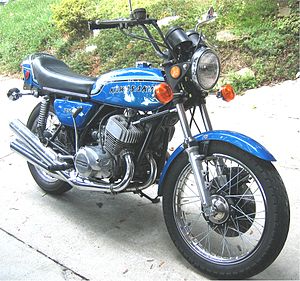Kawasaki 750 H2
| Kawasaki | |
|---|---|
 Kawasaki 750 H2 (1972) |
|
| Kawasaki 750 H2 | |
| Manufacturer | Kawasaki Heavy Industries, Ltd. |
| Production period | 1971 to 1975 |
| class | motorcycle |
| design type | Super athlete |
| Motor data | |
| 3 cylinder, two-stroke engine , air-cooled, slot-controlled | |
| Displacement (cm³) | 748 |
| Power (kW / PS ) | 54/74 at 6,800 min -1
52/71 at 6,800 min -1 (H 2 C) |
| Torque ( N m ) | 78 at 6,500 min -1
75.4 at 6,500 min -1 (H 2 C) |
| Top speed ( km / h) | 203 |
| transmission | 5-speed |
| drive | Chain |
| Brakes | front disc brake Ø 296 mm /
Rear ventilated full-hub simplex drum brake Ø 200 mm |
| Wheelbase (mm) | 1410 |
| Dimensions (L × W × H, mm): | 2080 × 850 × 1145 |
| Seat height (cm) | approx. 81 |
| Empty weight (kg) | 192 |
The Kawasaki 750 H2 was a motorcycle by the Japanese manufacturer Kawasaki that was manufactured from 1971 to 1975.
Technology and history
After the success of the Kawasaki 500 H1 , Kawasaki developed the Kawasaki 750 H2 ( Mach IV ) as the new top model. When it was launched in 1972, it was the most powerful and fastest mass-produced motorcycle. The quarter mile was completed in 12.283 seconds in a test. In the smaller classes, too, the range was rounded off in 1972 with the 250 S1 Mach I , in Japan as the 250-SS and 350 S2 Mach II (350-SS) and in 1974 with the 400 S3 Mach II (400-SS).
The mixture is prepared by three round slide carburetors Mikuni VM 30SC with 30 mm passage. The ignition was designed as a contactless CDI high-voltage capacitor ignition. A striking feature of the Kawasaki 750 H2 are the two exhaust pipes on the right side and another on the left.
Model years
The H2 was modified every model year:
- 1972 H2 (colors: Pearl Candy Blue and Pearl Candy Gold, UK only Candy Blue)
- 1973 H2-A : Chrome-plated front fender, metal side cover emblems instead of stickers. A holder for the replacement spark plug box was fitted into the rear apron. Lockable seat lock and tank cap. (Colors: Candy Gold, Candy Purple, Candy Blue)
- 1974 H2-B : Changes to the instruments, the frame, the seat, the paintwork, the footrests, the main stand, the mudguards, the handlebar fittings, the rear struts, the electrics, the tank cap and the taillight. The rear swing has been lengthened. The two-channel oil pump was developed into a four-channel pump. The friction damper for the steering head was removed, only the hydraulic steering damper remained. (Colors: Candy Gold, Candy Green)
- 1975 H2-C : Longer fuel tank, but shorter seat. The engine power dropped to 71 hp at 6800 min -1 , the torque of 75.4 Nm at 6500 min -1 , for the empty weight increased to 208 kg. The steering damper has been moved from the right side to the left side of the frame. (Colors: Candy Super Red, Candy Purple)
Legends and Trivia
"Like the widowmaker's wobbly chassis and the power delivery that is impossible to control, the central cylinder, which is permanently eating because of the slipstream of the front wheel, belongs to the realm of poison green legends."
The comic figure Hans Rainer Kabel (fr. Jean-Raoul Ducable) of the Joe Bar Team drives a Kawasaki 750 H2 .
Production summary table
| year | number of pieces |
| 1970 | 12 |
| 1971 | 15,945 |
| 1972 | 14,016 |
| 1973 | 7,813 |
| 1974 | 8,895 |
| 1975 | 800 |
| total | 47,481 |
literature
- Jürgen Gaßebner: Kawasaki milestones: Classic - Tuning - Racing . Elementbuch Verlag, Schlierbach 2007, ISBN 978-3-9811662-1-7 .
- Peter Mergelkuhl: Two-wheeled Kawasaki 750 H2 . In: OLDTIMER MARKET . No. 11 , 2009, ISSN 0939-9704 , p. 24-31 .
- Franz Josef Schermer: Repair Instructions Technology Special Volume No. 6008-February 2009. Motorbuch Verlag, from the series: Motorcycle Repair Instructions ISBN 3716820989 and ISBN 978-3716820988
Web links
- Kawasaki H2 750 / Mach IV, model 1971, built from 1971 to the end of 1975. In: http://www.zweitakte.de . Alfred Wiegärtner, accessed March 4, 2015 .
- Michael Pfeiffer: Kawasaki 750 H2. In: Finale. MOTORRAD online , November 21, 2008, accessed on March 4, 2015 : "A declaration of love"
Individual evidence
- ↑ The development and development of the Kawasaki H2 750, MACH IV and 750 SS from 1971 to 1975. In: http://www.zweitakte.de . Alfred Wiegärtner, accessed March 4, 2015 .
- ↑ Kay Liedtke: Project Heinz Zwo . In: MOTORRAD Classic, 7 + 8/2015, p. 94.
- ↑ Kawasaki MACH , MIKI PRESS, 2008, ISBN 978-4-89522-520-5 , p. 140, Japanese